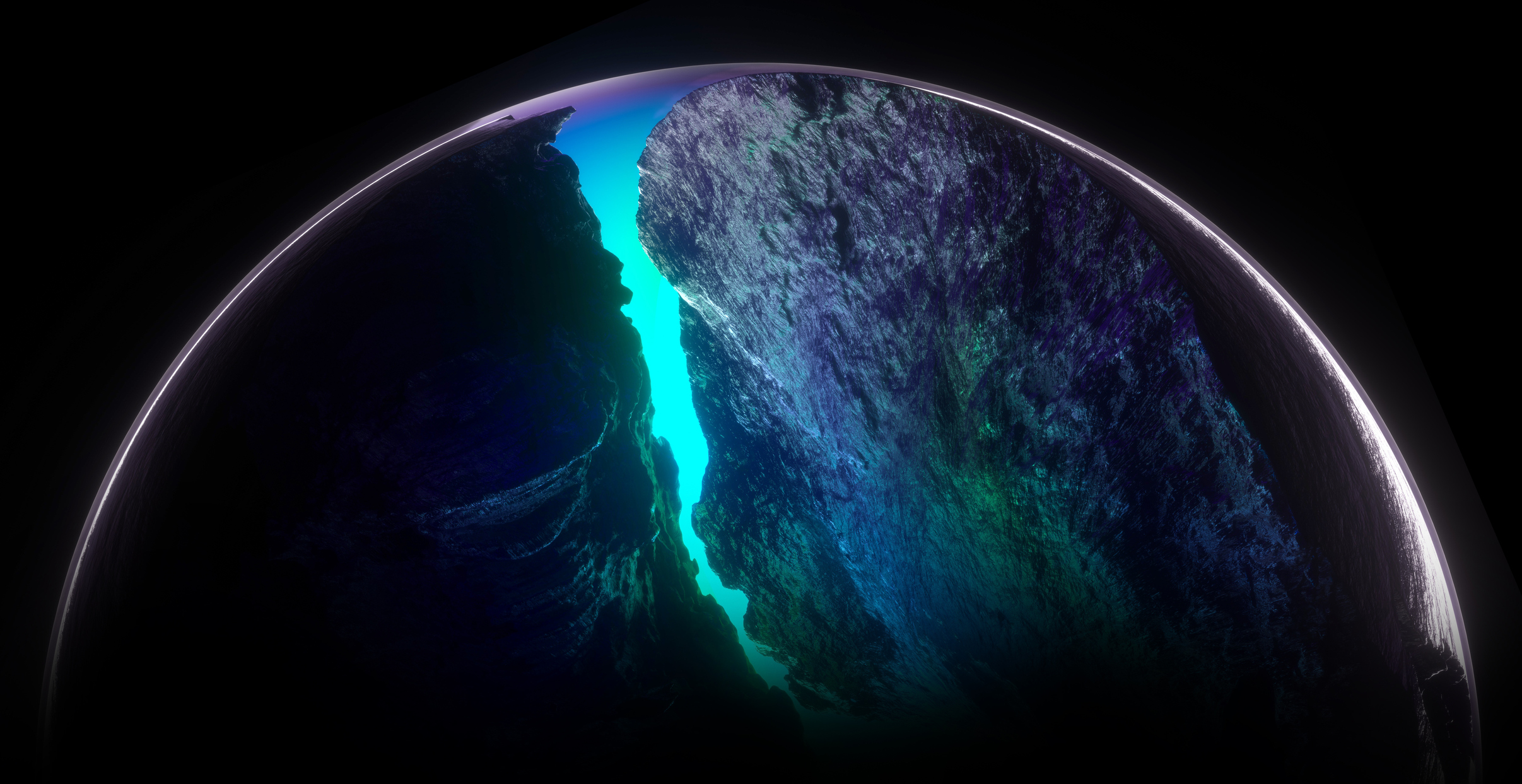Table of Contents
The ocean is unfathomably deep. So deep that the Mariana Trench, hidden beneath the ocean’s waves, would surpass Mount Everest in height, if our planet’s tallest mountain were placed inside it upside down.
Remarkably, a host of unique sea creatures survive and thrive in the Mariana Trench and a handful of humans in submersibles have also endured daunting expeditions to its floor. Their journeys continue to unravel the mysteries of this hidden underwater world.
What Is the Mariana Trench?
The Mariana Trench is the deepest part of the world’s oceans, located in the western Pacific Ocean. The weight of the ocean above it creates pressure around 15,750 pounds per square inch (more than 1,000 times what we experience on land) and the alien world is devoid of light.
Where Is the Mariana Trench?
It is located to the east of the Mariana Islands, a chain of volcanic islands, where it gets its name. Typical water temperatures hover just a few degrees above freezing. Despite the extreme pressure, lack of light, and frigid temperatures, the Mariana Trench hosts a variety of life forms. These include microorganisms, as well as larger organisms like amphipods, and possibly even fish, adapted to the extreme conditions.
How Was the Mariana Trench Formed?
The Mariana Trench was formed by a process known as subduction, where the Pacific Plate is being subducted under the smaller Mariana Plate. It first appeared on the radar of science in the 1870s during the multi-year Challenger Expedition, a monumental landmark in the history of undersea exploration, and has continued to be a significant point of interest in oceanography and marine biology.
Read More: H.M.S. Challenger: Humanity’s First Real Glimpse of the Deep Oceans
How Deep Is the Mariana Trench?
Some measurements in the Mariana Trench have charted depths exceeding 6.5 miles (or 36,000 feet) in the deepest spot, dubbed Challenger Deep. The average depth of the world’s oceans comes in around 12,000 feet, or 2.3 miles, according to a comprehensive research effort with the National Oceanic and Atmospheric Administration in 2010.
But this encompasses a seafloor that, similar to dry land, is rife with mountainous peaks, cavernous valleys and other dynamic topographic features.
Plenty of the rocky trenches and caves plunge many miles deeper, such as Challenger Deep within the Mariana Trench.
The regions that exceed roughly 3.5 miles, or 20,000 feet, are known as the hadal zone, named after Hades, Greek god of the underworld. Fitting right, given their abyss-like nature and mystery?
Read More: The Ocean Twilight Zone’s Mysterious ‘False Bottom’
What Lives in the Mariana Trench?
Such an extreme world holds a roundup of animals with extraordinary adaptations for survival.
Snailfish
The snailfish is the most dominant family of fish spotted within the hadal zone.
These creatures, which have been recorded at nearly 27,000 feet deep, possess a skeleton made of cartilage — likely to help sustain such high pressure — and a translucent exterior that reveals all their inner organs.
Cusk-eel
Cusk-eels have been recorded even deeper, just beyond 27,000 feet. Though they resemble an eel, they are actually fish closely related to tuna and seahorses.
Impressively, the cusk-eel can also be found in the shallowest parts of the ocean as well as the deepest, spanning an extraordinary range of viable conditions for survival.
Amphipods
Along with sea cucumbers, tiny flea-like crustaceans known as amphipods are the most abundant animal in the hadal zone. Research indicates they scavenge on debris floating down from upper ocean zones.
One unusually large species of amphipods, Alicella gigantea, can reach up to 13 inches in length.
Read More: How These 4 Deep Sea Sharks Lurk in the Ocean
Has Anyone Been to the Bottom of the Mariana Trench?
Yes, people have been to the bottom of the Mariana Trench. The two most well known expeditions include Don Walsh and
Who Went to the Bottom of the Mariana Trench First?
After its discovery, nearly 100 years passed before a human, U.S. naval officer Don Walsh and Swiss oceanographer Jacques Piccard, in 1960 reached the bottom of the Challenger Deep canyon inside a deep-sea vessel.
Did James Cameron Go to the Mariana Trench?
Yes, Canadian filmmaker and ocean explorer James Cameron made a similar solo journey into the abyss in 2012. Since then, roughly half a dozen ocean explorers have successfully reached the bottom of the Mariana Trench — and many more remotely operated vehicles have completed expeditions.
One crew recently acquired water samples from the depths for the Natural History Museum in Washington D.C.
Read More: What It’s Like to Dive to the Titanic in a Submersible
What Is at the Bottom of the Mariana Trench?
Just last year, Dawn Wright, an oceanographer who specializes in marine geology, became the first Black researcher to descend to the bottom of Challenger Deep.
Alongside submersible pilot Victor Vescovo, the team successfully tested a side-scan sonar technology capable of taking detailed images of the seafloor at 36,000 feet.
Read More: We’ve Only Explored Less Than 5 Percent of the Ocean Floor
They also made a more unsettling discovery, captured on camera as one of the first objects in view after touching down roughly 6.7 miles below the ocean’s surface: a beer bottle.
Wright later shared the image on Twitter, with a sobering message for all to consider: “[It’s] further evidence that we must as humanity do better by the ocean and for the health of habitats that we ourselves share and ultimately depend on.”
Mariana Trench Frequently Asked Questions
Is the Mariana Trench the Deepest Part of the Ocean?
Yes, the Mariana Trench is the deepest part of the ocean. Its deepest point, known as the Challenger Deep, reaches approximately 10,984 meters (36,037 feet) below sea level, making it the deepest known point on Earth.
When Was the Mariana Trench Discovered?
The Mariana Trench was first discovered and identified in 1875 during the Challenger expedition, a pioneering oceanographic expedition led by the British Royal Navy. This expedition, which lasted from 1872 to 1876, was aimed at exploring the depths of the world’s oceans.
Is the Titanic in the Mariana Trench?
No, the Titanic is not located in the Mariana Trench. The wreck of the Titanic lies in the North Atlantic Ocean, about 600 kilometers (370 miles) south-southeast off the coast of Newfoundland, Canada, at a depth of about 3,800 meters (12,500 feet).
How Wide Is the Mariana Trench?
The Mariana Trench is about 2,550 kilometers (1,580 miles) long and averages 69 kilometers (43 miles) in width. The trench forms a crescent-shaped scar in the Earth’s crust.
How Many People Have Been to the Mariana Trench?
Very few people have descended to the Challenger Deep, the deepest part of the Mariana Trench. This includes the historic trip by Jacques Piccard and Don Walsh in the Trieste in 1960, James Cameron’s solo dive in 2012, and several dives by Victor Vescovo and his team in 2019.
What Does the Mariana Trench Look Like?
The Mariana Trench is a dark, remote, and largely unexplored area. Its terrain features steep, rocky walls and a sediment-covered floor. The conditions are extreme, with immense pressure, near-freezing temperatures, and complete darkness, except for bioluminescent organisms.
What Type of Plate Boundary Is the Mariana Trench?
The Mariana Trench is an oceanic-oceanic convergent plate boundary. It forms where the Pacific Plate is subducting beneath the smaller Mariana Plate.
How Can Fish Survive in the Mariana Trench?
Fish and other organisms in the Mariana Trench have adapted to survive the extreme conditions of high pressure, low temperature, and lack of light. These adaptations include specialized body structures, slow metabolism, and the ability to withstand high pressure.
Read More: The Search For Earth’s Underground Oceans
This article was originally published on June 27, 2023 and has since been updated by the Discover staff.





